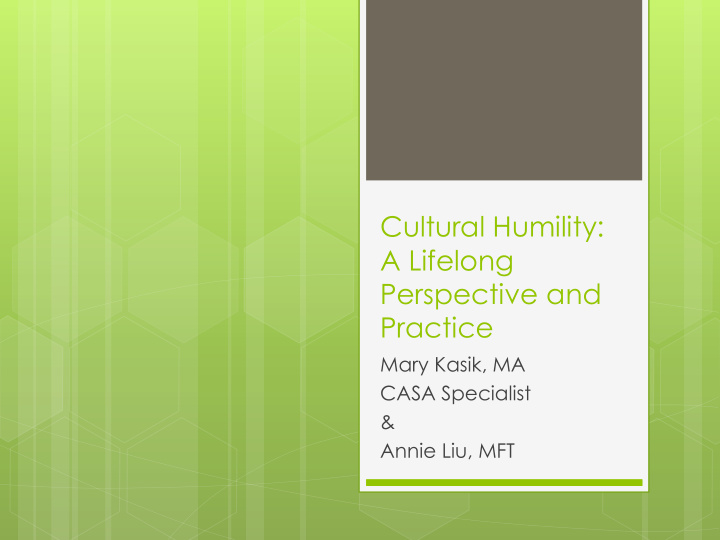



Cultural Humility: A Lifelong Perspective and Practice Mary Kasik, MA CASA Specialist & Annie Liu, MFT
Culture….
Cultural Humility is: A stance toward understanding culture. It requires a commitment to lifelong learning, continuous self- reflection on one’s own assumptions and practices, comfort with ‘not knowing’, and recognition of the power/privilege imbalance that exists between clients and health professionals. An interactive approach: we approach another person with openness to learn; we ask questions rather than make assumptions; and we strive to understand rather than to inform.
Agreements Honor Confidentiality Unconditional Respect for Yourself & Others Speak Your Truth No Put-downs Agree to Disagree Everyone Has the Right to Pass Experience Discomfort Be conscious of body language and nonverbal responses -- they can be as disrespectful as words. Expect and Accept Non-closure Anything Else?
Activity: My String of Beads Go around the room to each of the 7 stations and read the statements silently. Take 1 bead for each statement that applies to you and string it on your cord. What do you think this activity was about? How did it make you feel? What can you do with your privilege?
A Trip to the Grocery Store Joy DeGruy, Author and Educator https://www.youtube.com/watch?v=GTv U7uUgjUI
Activity: Power Shuffle Honor confidentiality Unconditionally respect yourself and others Speak for yourself only Actively listen No put-downs Give caring feedback This exercise will include a dialogue, not a debate Agree to disagree Everyone has the right to pass It is okay to express your emotions No “rescuing” Take responsibility for you own learning - ask for what you need.
The Goal An examination of one’s prejudices, an effort to truly understand and empathize with others, the development of an appreciation of differences, and, hopefully, the establishment of real, positive connection.
Putting it into Action Take 5-10 minutes to talk within a group and write down ways your workplace can adopt a cultural humility approach with its staff, clients, etc.
Ableism Videos *TRIGGER WARNING* https://www.youtube.com/watch?v=amX wzh1cL9U https://www.ted.com/talks/stella_young_i _m_not_your_inspiration_thank_you_very_ much#t-300597
References Tervalon, M. and Murray-Garcia, J. (1998). Cultural humility versus cultural competency: a critical distinction in defining physician training outcomes in multicultural education. [Editorial Research Support, Non-U.S. Government P.H.S. Review]. Health Care Poor Underserved, 9(2) 117-125. Lee Gardenswartz and Anita Rowe (1994). The Diversity Tool Kit. The McGraw-Hill Companies.
Recommend
More recommend